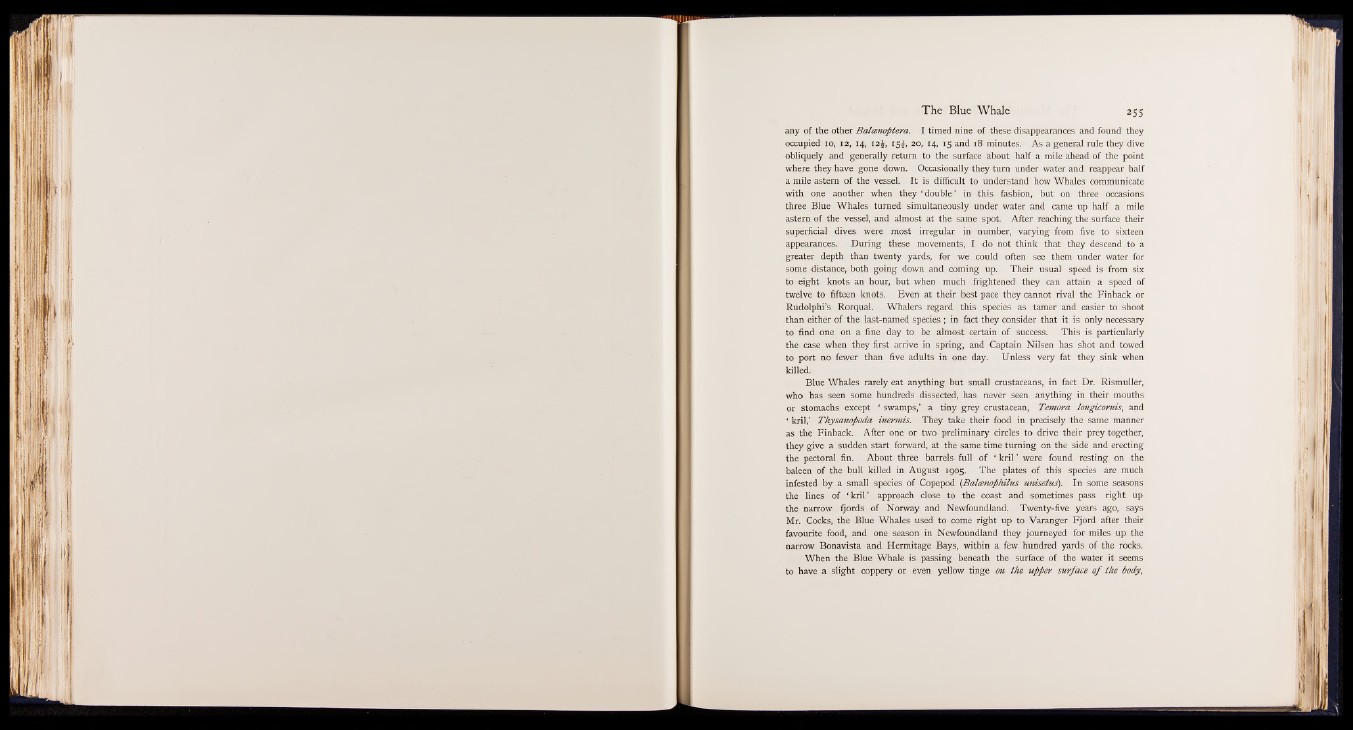
The Blue Whale 255
any of the other Balcenoptera. I timed nine of these disappearances and found they
occupied 10, 12, 14, 12J, 15^, 20, 14, 15 and 18 minutes. As a general rule they dive
obliquely and generally return to the surface about half a mile ahead of the point
where they have gone down. Occasionally they turn under water and reappear half
a mile astern of the vessel. It is difficult to understand how Whales communicate
with one another when they ‘ double ’ in this fashion, but on three occasions
three Blue Whales turned simultaneously under water and came up half a mile
astern of the vessel, and almost at the same spot. After reaching the surface their
superficial dives were most irregular in number, varying from five to sixteen
appearances. During these movements, I do not think that they descend to a
greater depth than twenty yards, for we could often see them under water for
some distance, both going down and coming up. Their usual speed is from six
to eight knots an hour, but when much frightened they can attain a speed of
twelve to fifteen knots. Even at their best pace they cannot rival the Finback or
Rudolphi’s Rorqual. Whalers regard this species as tamer and easier to shoot
than either of the last-named species ; in fact they consider that it is only necessary
to find one on a fine day to be almost certain of success. This is particularly
the case when they first arrive in spring, and Captain Nilsen has shot and towed
to port no fewer than five adults in one day. Unless very fat they sink when
killed.
Blue Whales rarely eat anything but small crustaceans, in fact Dr. Rismuller,
who has seen some hundreds dissected, has never seen anything in their mouths
or stomachs except ‘ swamps,’ a tiny grey crustacean, Temora longicornis, and
‘ kril,’ Thysanoftoda inermis. They take their food in precisely the same manner
as the Finback. After one or two preliminary circles to drive their prey together,
they give a sudden start forward, at the same time turning on the side and erecting
the pectoral fin. About three barrels full of ‘ kril ’ were found resting on the
baleen of the bull killed in August 1905. The plates of this species are much
infested by a small species of Copepod (Balcenophilus unisetus). In some seasons
the lines of ‘ kril ’ approach close to the coast and sometimes pass right up
the narrow fjords of Norway and Newfoundland. Twenty-five years ago, says
Mr. Cocks, the Blue Whales used to come right up to Varanger Fjord after their
favourite food, and one season in Newfoundland they journeyed for miles up the
narrow Bonavista and Hermitage Bays, within a few hundred yards of the rocks.
When the Blue Whale is passing beneath the surface of the water it seems
to have a slight coppery or even yellow tinge on the upper surface o f the body,